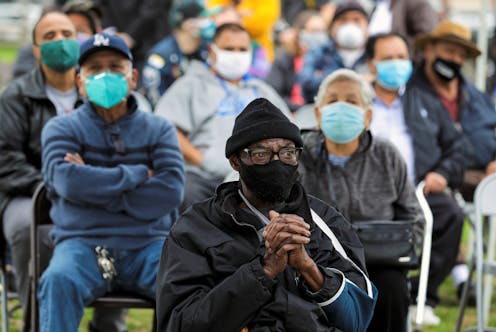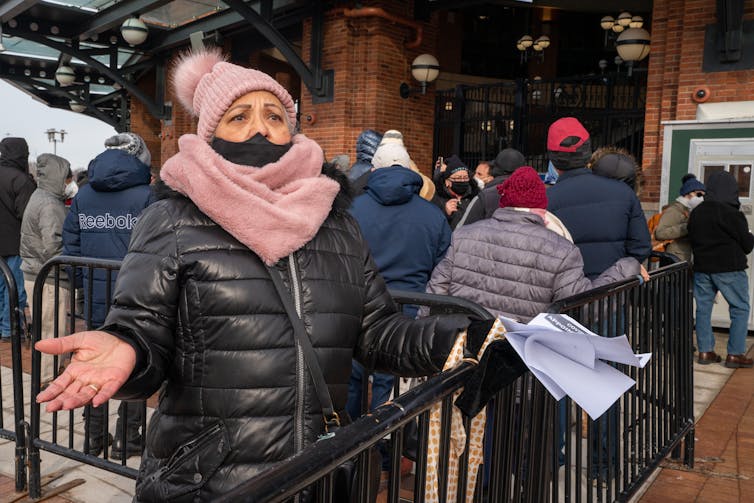How to really fix COVID-19 vaccine appointment scheduling
Websites that crash. Appointments that fill up within seconds. Scheduling your COVID-19 vaccine shouldn't be this hard. A few states have found a better way.

If you’ve tried to get a COVID-19 vaccine appointment, you know how frustrating the process can be. People are spending hours obsessively refreshing websites, hoping an appointment will open up somewhere. They scan Facebook groups for tips and insider information. One writer compared it to Soviet-style queues for cabbage.
The competition for slots will only worsen when the COVID-19 vaccination priority list opens to the broader public.
It doesn’t have to be this way. Much of this misery comes from poorly designed vaccine sign-up websites, but the problem is more fundamental.
As an expert in health care operations and vaccine supply chains, I have closely followed the difficulties in connecting COVID-19 vaccine doses with people. I believe the best solution to vaccine appointment scheduling lies in building a trustworthy one-stop preregistration system. The U.S. is now near half a million deaths from COVID-19, and new fast-spreading variants of the coronavirus are adding to the urgency. As states scramble to speed up vaccinations and try to prevent their limited doses going to waste, a handful of them are testing this approach.
Why did the traditional model go so wrong?
The traditional vaccine sign-up model does not work when the demand for vaccines far exceeds supply.
Under that model, the only way to get vaccinated is to reserve an appointment slot. Naturally, the fear of being left out drives people to attempt to sign up as soon as appointment slots become available. This leads to a rush of people endlessly refreshing the same websites for the few appointments available.

Even if all states had one-stop appointment websites that did not crash under high volume, the limited vaccine supply would mean most appointment slots would quickly be taken. That could make it even harder for people who aren’t tech-savvy to get the vaccine.
To fix the broken vaccine scheduling system, we need to break this cycle.
What preregistration can solve
Most people have fairly realistic expectations about when they will be vaccinated. Their anxiety comes from the fear of being left out. To address this anxiety, the system must be designed to reassure people that they will receive vaccines within a reasonable time frame.
In Israel, which leads the world in COVID-19 vaccination, citizens do not need to actively sign up for vaccine appointments. Rather, they are notified when they become eligible via text messages and can then make an appointment.
States can echo this “push” system by creating a one-stop preregistration portal where everyone registers once and is notified to schedule appointments when their turn arrives. The preregistration step helps avoid waves of people trying to get appointments at the same time, which can crash computer systems, as Massachusetts experienced on Feb. 18.
A good system will make it easy for people to check their position in the vaccine queue at any time, provide an estimated time to vaccination based on frequently updated supply information and then send notifications when their date is getting close. Underlying the system, vaccine doses can be allocated among eligible users on the registry using a lottery system.
A well-designed preregistration system can also help avoid vaccine doses going to waste because of no-shows. With an active waitlist, vaccine planners can match supply with demand in an agile manner and offer appointments to people a few days in advance rather than scheduling appointments weeks out when the supply isn’t certain. Research in appointment scheduling has shown that no-shows are more likely under long lead times.
West Virginia sets an example
West Virginia uses a statewide preregistration system and has so far been more successful at vaccinating its population than almost every other state. It controls the process from preregistration to appointment. To get the vaccine, almost all residents, with a few exceptions, are required to use the state system, with options to register either online or by phone.
Minnesota just launched a similar system. “We still have a frustratingly limited vaccine supply from the federal government, but every Minnesotan should know their chance to get a vaccine will come. Today, we are connecting them directly to that process,” Minnesota Gov. Tim Walz said in announcing the preregistration system on Feb. 18.
More states should follow their lead as more of the general population becomes eligible for the vaccine in the coming months.
In Massachusetts, where a vaccine sign-up website crashed shortly after launching, nearly every member of the state’s congressional delegation has urged Gov. Charlie Baker to launch a preregistration system. A few other states already have limited preregistration systems that could be expanded.
It still takes coordination
Preregistration can still create confusion if the process isn’t coordinated and users don’t know what to expect.
In Virginia, for example, counties created their own preregistration systems, but when the pharmacy chain CVS announced it was taking appointments, users didn’t know what to do. Most Virginia counties are now shifting to a statewide preregistration system. In Santa Cruz County, California, residents have struggled with a preregistration portal that doesn’t provide confirmation or an estimated time to vaccination.
“Efficiency-equity trade-off” has become a buzzword in discussing COVID-19 vaccination. With limited vaccine supply, the traditional sign-up model has proven to be both inefficient and inequitable. Moving away from that model and establishing one-stop preregistration systems is one key to resolving the painful vaccine scheduling process.
Tinglong Dai does not work for, consult, own shares in or receive funding from any company or organization that would benefit from this article, and has disclosed no relevant affiliations beyond their academic appointment.
Read These Next
Whether Netflix or Paramount buys Warner Bros., entertainment oligopolies are back – bigger and mor
Hollywood has seen this movie before.
Black-market oil buyers will push Venezuela for bigger discounts following US seizure – starving Mad
Venezuela relies on the black-market oil trade for a large chunk of its revenue. US enforcement actions…
‘Are you married?’ Why doctors ask invasive questions during treatment
Answering personal questions at the doctor’s office can help researchers recognize health problems…





